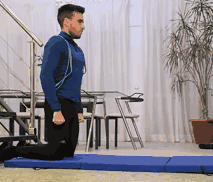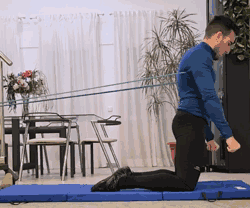Calisthenics has always had a reputation of being a really bad leg builder, and it kinda is. But there are ways certainly ways to make it work. Here I present two leg exercises that I think are really good at targeting the hamstrings and quads and how to progress on them. I think this are relatively underrated exercises overall.
Nordic curl
The nordic curl is in my honest opinion the best hamstring exercise period, you get your legs stuck under something and control your descent to the floor with your hamstrings. Once you are flat with the floor, you flex (thus curl) your hamstrings and get back up. If you aren’t able to curl yourself up, just doing the eccentric part of the movement (the first part) in and of itself.
I use my stairs to hold my feet and I use elastic bands to help (this exercise is really difficult, so don’t feel bad if you need a lot of help). I’m for bands and against using your hands to help you back up because bands are a repeatable and measurable way to help yourself and this allows for easier progressive overload. To increase the load I make the string longer so the bands help me less and later in the movement.
I like using elastic bands here because they won’t help at all on the easy part where you are mostly upright, but they help on the most difficult part, making you work as hard as you can where is difficult and taking the training wheels as soon as you are able to finish the movement.

As you can see in the image I use a pad on my knees, this not only makes it more comfortable but more importantly it puts the back of my foot closer to the stair.
You can also see I bend my hip a little, this isn’t ideal, you could call it cheating, but the body knows how to cheat when things get real and you can’t always help it.
Bodyweight leg extensions
Bodyweight leg extensions aren’t just a good quad exercise but also a good quad stretch, so you get the benefits of strengthening and a bit of mobility work. Great exercise overall even if it won’t get you tree trunk legs. This exercise is hard on the knees, so proceed at your own discretion.
As you see in the image, you get on your knees and fall backwards as deep as you can go, then you spring forwards again.

When the bodyweight variation gets too easy, you can resort to using an elastic band to make the exercise more difficult as you see in the image.

Bands or weights?
Let’s look at the exercise. When you are bent back the difficult is as hard as it can be, the force points downwards so it’s as perpendicular with your body as it can be, making it hard. When you are upright the force is parallel with your body making it almost trivial.
If you add a backpack with weights, the exercise gets harder on the hard part as you are adding more weight, obviously. On the easy part it doesn’t really get much harder as gravity scales trigonometrially with the angle of the knee.
If you add bands intead as in the image above, the hard part doesn’t get that much harder, the band is shortened, instead the band makes the easy part harder, that way the difficulty curve is more uniform.
In reality, as you progress, maybe a mix of both approaches is best. Beware how much weight you add, this exercise puts the knee in a somewhat vulnerable position, always add weight with caution and condition the knee properly.
